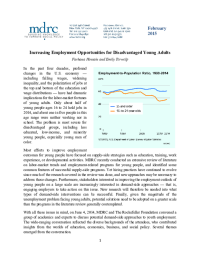Increasing Employment Opportunities for Disadvantaged Young Adults

In the past four decades, profound changes in the U.S. economy — including falling wages, widening inequality, and the polarization of jobs at the top and bottom of the education and wage distributions — have had dramatic implications for the labor-market fortunes of young adults. Only about half of young people ages 16 to 24 held jobs in 2014, and about one in five people in this age range were neither working nor in school. The problem is most severe for disadvantaged groups, including less educated, low-income, and minority young people, especially young men of color.
Most efforts to improve employment outcomes for young people have focused on supply-side strategies such as education, training, work experience, or developmental activities. MDRC recently conducted an extensive review of literature on labor-market trends and employment-related programs for young people, and identified some common features of successful supply-side programs. Yet hiring practices have continued to evolve since much of the research covered in the review was done, and new approaches may be necessary to address those changes. Furthermore, stakeholders interested in improving the employment outlook of young people on a large scale are increasingly interested in demand-side approaches — that is, engaging employers to take action on this issue. New research will therefore be needed into what types of demand-side interventions can be successful. Finally, given the magnitude of the unemployment problem facing young adults, potential solutions need to be adopted on a greater scale than the programs in the literature review generally contemplated.
With all these issues in mind, on June 4, 2014, MDRC and The Rockefeller Foundation convened a group of academics and experts to discuss potential demand-side approaches to youth employment. The wide-ranging conversation reflected the diverse backgrounds of the attendees, who contributed insights from the worlds of education, economics, business, and social policy. Several themes emerged from the conversation.
Employers are a heterogeneous group with diverse needs, goals, and preferences.
Many employers do already partner with school-to-work initiatives and “second-chance” programs for young adults who are neither working nor in school. The research evidence on what motivates them to do so or to hire disadvantaged young people is limited, but it appears that their motivations vary. A few studies have pointed to a sense of social responsibility and philanthropy as the primary motivating factors, but others say that public recognition matters as well. Forum attendees agreed that these angles have the potential to gain the attention of some employers, especially if they see their peers and competitors leading the way.
Employers may respond to financial incentives, but incentives are not likely to be the only force motivating their decisions, and wage subsidies have actually been shown to stigmatize groups of workers.
Forum experts challenged the notion that employers make individual hiring decisions solely based on the proverbial “bottom line,” citing complex and evolving recruiting processes that vary widely by employer and industry. However, the group did believe that financial incentives like tax credits and wage subsidies could get some employers more involved in youth employment. Attendees mentioned in particular a tax credit used to expand apprenticeship programs in South Carolina and the federal Work Opportunities Tax Credit available to employers for hiring individuals with certain barriers to employment.
The group also acknowledged that prior research suggests highly targeted financial subsidies may actually stigmatize the workers they target. Employers may not respond positively to financial incentives if they do not believe that young workers will make good hires, and many employers are likely to have a dim view of young workers’ skills, experience, and work ethic.
Employers are more likely to engage in youth employment efforts if it is easy for them to do so and if they believe it is a positive opportunity for their businesses.
The experts agreed that any effort to engage employers in hiring more young people should include a marketing component to change the way many employers have come to view young workers, educate them about the potential of a young and diverse workforce, and debunk myths about young workers that may be based in stereotypes. Attendees also underscored the importance of “keeping it easy” for employers when encouraging them to engage in any youth workforce initiatives. Technical assistance providers and workforce intermediaries can contribute to that goal.
Employers’ growing use of third parties to recruit and screen new employees has significant implications for efforts to increase the hiring of disadvantaged young adults.
While employers’ use of staffing or temporary placement agencies to meet short-term labor needs is not a new practice, more and more employers are relying on such contingency staffing agencies to increase workforce flexibility and reduce recruitment and screening costs.[1] Experts at the forum also spoke about the growing trend toward “recruitment process outsourcing,” where many employers are transferring all or part of the recruitment process to an external service provider. Since these third-party actors serve as the first line of contact between many employers and job seekers, they may play a key role in any efforts to improve labor-market outcomes for disadvantaged young adults. It is important to understand how they interact (or do not interact) with young job seekers — for example, where they look for candidates and how they select candidates for entry-level positions.
Widespread adoption of computerized applicant tracking systems has also changed the way employers interact with job seekers.
These systems function most simply as databases in which firms can manage their recruitment efforts and applicant information, but many also perform screening functions (for example, by searching résumés for key words or years of experience). The effects of computerized hiring mechanisms are not yet fully understood, especially for disadvantaged job seekers. On one hand, forum experts pointed out that computerized screening could potentially decrease the effects of discrimination and stigma by removing human bias and subjectivity. However, these automated systems are still likely to reflect the values of the employers and the recruiters who design them, and more importantly, the ability of these systems to match candidates to jobs depends on how well they are designed.
In the face of these changing practices, disadvantaged young workers need assistance communicating their skills and experience. Credentialing mechanisms could help.
The low-skill, low-wage jobs offered in many paid work experience programs can improve the economic situations of young adults in the short run, but they are not likely to offer significant wage growth or advancement opportunities. Low-skill, low-wage jobs are not likely to be attractive to young people or to improve their labor-market outcomes in the long run unless they can lead to jobs that offer opportunities for further skill enhancement and economic advancement.
For that to happen, young workers need to be able to communicate the skills and experience they gain in entry-level and low-skill jobs. In recent surveys, employers often cite “soft skills” (the general habits and competencies that make for an effective employee) as vitally important to their hiring decisions, and entry-level jobs can provide those skills. Yet such skills are much more difficult to communicate than academic or technical skills, and most entry-level jobs in industries that hire young people, like retail or food service, do not offer industry-recognized credentials that workers can use to signal their employability. This stands in contrast to industries like information technology and health care, where certificates and formal credentials indicate that their holders are qualified to perform the duties of specific jobs. If industries like retail or food service were to specify some standard core competencies required for low-skill, entry-level jobs and adopt credentialing mechanisms, it could help young workers communicate their skills and experience to new employers.
Simple forms of support in entry-level jobs can put young adults on the path to success.
Young adulthood is a period of transition marked by many changes, as young people go from job to job, into and out of education and training, and through periods of unemployment. All young workers need support during this period of instability, and disadvantaged young adults have fewer resources and fewer adult role models to help them. Since early work experiences can have a lasting impact on an individual’s performance in the labor market, experts discussed simple ways employers can help young workers perform well in their jobs and potentially set them on a path to long-term success.
For example, evidence from job-related youth programs suggests that simple actions like providing alarm clocks, text-message alerts, or subsidized transportation passes can help mitigate challenges faced by disadvantaged young people and improve their performance. Research also suggests that support and supervision from caring adults can have a positive impact on the professional and personal development of young workers, and experts discussed how managers of entry-level workers can be a source of built-in support for them. Many employers already provide management training, through which managers could learn to support the development and professional growth of young employees. Reiterating the need to “keep it easy” for employers, some attendees also suggested that intermediary organizations could help employers connect young workers to the support they need.
To address the issue of youth unemployment at a transformative scale, demand-driven approaches can take on whole geographic areas or whole industries.
Forum attendees talked about how demand-driven initiatives can make use of existing structures and systems to reach as many young people as possible. Sector-based models and geographically organized systems present two promising mechanisms. In a sector-based approach, employers in a specific industry work collectively with supply-side training programs to address their needs for labor and skills. Along similar lines, large employers — franchises with multiple locations or businesses with large supply chains — could effectively tackle the problem from the demand side on a large scale. Large cities or regions with strong youth-services networks could be fertile environments to pilot test large-scale youth employment strategies, especially ones that build on efforts already under way to link employers, intermediaries, and job seekers.
Experts also emphasized the need to strengthen the link between the education system and the business community. Career Academies — high schools that rely on strong employer partnerships to combine academics with career development opportunities — have been shown to produce sustained improvements in students’ employment and earnings, particularly among young men. Similar approaches that engage employers in creating curricula and providing work experience to high school and college students can go a long way towards addressing youth unemployment.
The conversation on June 4 and MDRC’s review of research evidence both underscore the need for more definitive evidence.
More research is needed to determine what works in helping disadvantaged young adults improve their labor-market outcomes. The search for demand-driven solutions should be accompanied with plans for rigorous research that will yield solid evidence about the effectiveness of various approaches.
[1]Tian Luo, Amar Mann, and Richard Holden, “The Expanding Role of Temporary Help Services from 1990 to 2008,” Monthly Labor Review (August 2010), 3-16.







